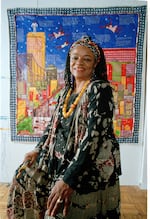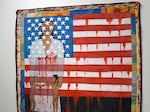
Artist Faith Ringgold sits before her quilt "Tar Beach" in 1993. The artwork also inspired a children's book of the same name.
Kathy Willens / AP
Artist Faith Ringgold, well known for her story quilts depicting African-American experiences, has died. She was 93.
Her death was confirmed by her assistant Grace Matthews, who said Ringgold died at her home Saturday in Englewood, N.J.
Ringgold also created paintings, sculptures, performance art and children's books. Her work focused on Black life, feminine life and the crossroads between the two.
One of her first and most famous story quilts is called "Who's Afraid of Aunt Jemima." It began with her observation about the changing face of a certain pancake brand.
"You know the Aunt Jemima pancake box?" Ringgold said to Fresh Air's Terry Gross in 1991. "If you look at the early ones when I was a kid, she was much darker ... her nose was wider, her lips were fuller, and she was fatter. ... And so I wanted to pay tribute to all of these Aunt Jemimas that we have in all of our families — these strong and very powerful women who sometimes don't pay attention to their weight because they're so busy nurturing and feeding the whole family."
The result is a quilt with square panels showing Black women next to panels of kids, teens, adults, white, and Black. Panels of written text and decorative fabric swatches are checkered between the people.
In story quilts like this one, Ringgold worked in a medium with deep ties to African-American slavery. However, it wasn't her original medium. She wanted to paint landscapes.
She told NPR in 2013 about trying to get those landscapes shown at a big-time New York gallery. This was during the civil rights movement, and gallery owner Ruth White turned her down.
"And she says to me: 'You can't do that. You're a Black woman, and you're painting landscapes? This is the middle of the '60s — all hell is breaking loose all over the country,'" Ringgold said.
Ringgold's art changed. She began reading work by James Baldwin and Amiri Baraka and became a part of the Black Arts Movement.

A visitor watches the work of artist Faith Ringgold, "The Flag is Bleeding #2" during a preview on December 4, 2019.
Leila Macor / AFP via Getty Images
In 1963, she began a series of paintings called The American People. They are haunting, at times, violent depictions.
One of them, called "Die," depicts a street riot. Another, "The Flag Is Bleeding," shows just that.
"It was what was going on in America," Ringgold said in 2013. "And I wanted them to look at these paintings and see themselves. Look and see yourself."
Faith Ringgold was born in 1930 in Harlem, New York City. She had asthma and spent a lot of time at home making art as a child. She eventually went to art school.
Ringgold learned to quilt from her family. Her mother, Willi Posey Jones, made dresses; she worked with her daughter to create Ringgold's first story quilt.
As Ringgold got older, her imagery became less angry. She eventually began writing and illustrating children's books. Late in her career, she enjoyed more exhibitions around the world and major retrospectives of her art.
Adrienne Childs is an art historian and curator. She says Ringgold influenced a generation of artists.
"Faith Ringgold opened the door for younger artists — for artists after her, Black artists in particular — to carry their message through these alternative kinds of media," Childs said.
Childs said she had a favorite Faith Ringgold book to read to her own kids when they were young: Tar Beach. Based on one of her own story quilts, Tar Beach tells the story of a young girl lying on an apartment rooftop while her parents and their friends have a picnic, imagining herself flying above the city.
At the end of Tar Beach, the girl tells her little brother that anyone can fly. "All you need," Ringgold wrote, "is somewhere to go that you can't get to any other way."
Copyright 2024 NPR. To see more, visit https://www.npr.org.